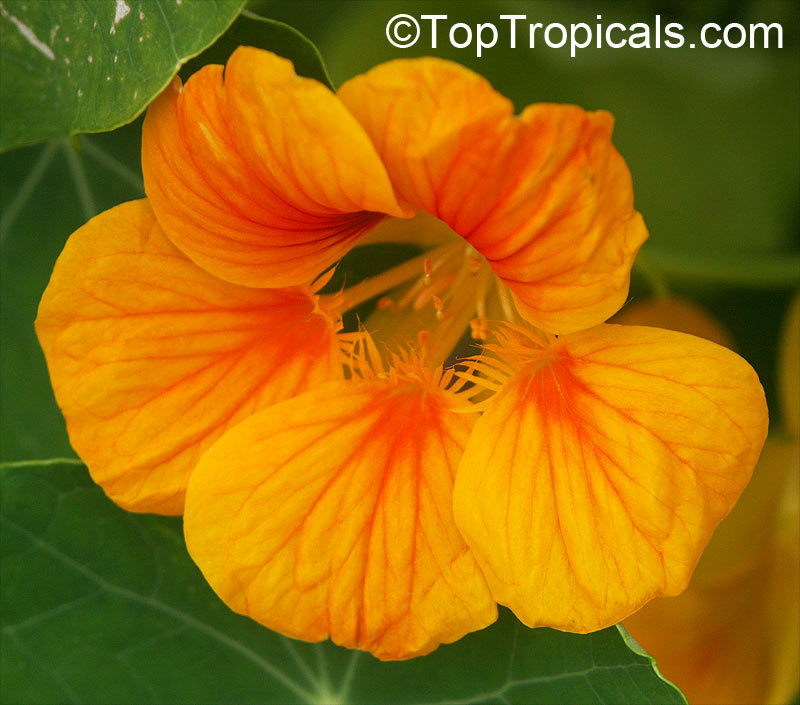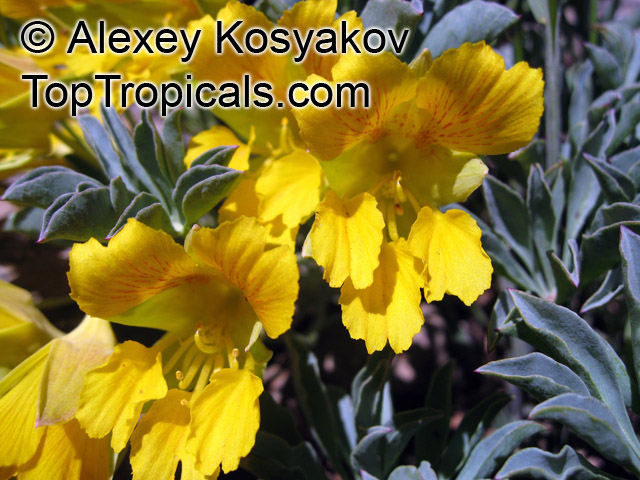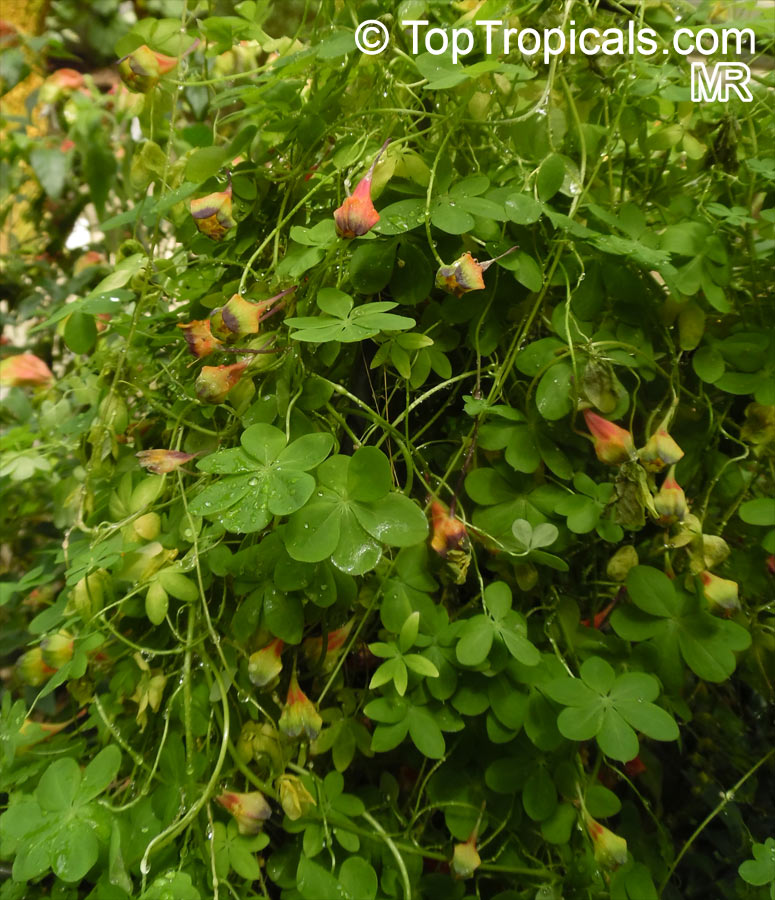Tropaeolaceae - Botanical Family
| Number of plants found: 6 |
Botanical name: Tropaeolum majus
Common names: Garden Nasturtium, Indian Cress, Monks Cress
Family: Tropaeolaceae
Origin: South America
Hardiness: 0°F















Tropaeolum majus (garden nasturtium) is a fast-growing herbaceous annual native to the Andes from Bolivia north to Colombia. Cultivated varieties have hybrid origin, with possible parent species including T. minus, T. moritzianum, T. peltophorum, and T. peregrinum. Plants form trailing or compact mounds, with rounded, shield-shaped leaves attached at the center. The showy flowers, in shades of yellow, orange, and red, appear over a long season and are both ornamental and edible. Leaves and flowers have a peppery flavor and are commonly used fresh in salads and as colorful garnishes. Seeds can be pickled as a caper substitute.
Grow nasturtiums in full sun with moist, well-drained soil. Compact forms stay around 12 in tall and make colorful borders, while trailing types can reach several feet and are suited to hanging baskets, window boxes, or ground cover. The plants are low-maintenance, tolerate poor soils, and may self-seed in mild climates. Hardy as an annual in most regions; perennial in frost-free areas.
Botanical name: Tropaeolum minus
Common name: Dwarf Nasturtium
Family: Tropaeolaceae
Origin: Ecuador, Peru










Dwarf nasturtium is an annual to short-lived perennial plant growing around 30cm tall.
The plant provides edible flowers, leaves and seeds, has insect repellent properties and various medicinal applications.
Botanical name: Tropaeolum moritzianum
Common name: Moritz-Nasturtium
Family: Tropaeolaceae
Origin: South America








Botanical name: Tropaeolum peregrinum
Common names: Canary Creeper, Canarybird Flower, Canarybird Vine, Canary Nasturtium
Family: Tropaeolaceae
Origin: South America









This vigorously climbing vine or creeper is native to South America and grows to around 2-3m tall. The fast-growing, twining stems with heart-shaped leaves and bright yellow, orange flowers will brighten up any garden with its spicy aroma. The Canary Creeper is a great choice for all gardens, attracting butterflies, hummingbirds, and adds a unique flavor to dishes.
Like other flowering Nasturtium, the flowers, seeds, leaves and even the stems, of your Canary Creeper plants are edible. Use early seeds as a substitute for capers, or add the leaves and flowers to salads.
The Canary Creeper flower enjoys full sun to semi-shade and requires regular to moderate water and a moist, well-drained soil. Most of all it likes and grows lush in a warm sunny spot. An occasional pruning will help keep the plant tidy. In cold northern regions such as USDA zones 9-11, you can grow the Canary Creeper in a pot, as a houseplant and indoors, as long as it's given enough light and a few hours of sun daily. Make sure to protect them from extreme cold. These plants can mature to a cold hardy state of at least 30s F for a short amount of time.
If potted as a houseplant, water it as often as you can every week, but make sure that the soil dries out somewhat between waterings. Dry soil can cause leaves to go limp and some yellowing in the oldest leaves, but the plant should quickly recover with regular water. For best growth, feed your Canarybird flower with a liquid fertilizer every two weeks during the blooming season.
Botanical name: Tropaeolum polyphyllum
Common names: Wreath Nasturtium, Andean Nasturtium
Family: Tropaeolaceae
Origin: Argentina, Chile









It is a caudiciform plant, meaning it develops a type of enlarged, swollen root known as a caudex in its native habitat. It is a fast-growing small shrub that typically grows in clumps ranging from 2 to 5 feet in size. This plant prefers full sun to semi-shade, although it needs shade in places with extremely hot climates. It requires moderate water and can also tolerate dry conditions. This species is native to Argentina and Chile.
It has bright yellow or orange blooms with five petals, which are produced on branched clusters during late spring and summer. The flowers stand at the top of the stems and sometimes grows up to 8 inches long.
Tropaeolum polyphyllum is a strongly cold-susceptible plant and its tubers are winter-hardy to around 30s F only. This is best grown in temperate zones, preferably USDA Zone 6-10, with Pot culture the best option for cold regions.
When it comes to care, one should water sparingly in the pot with well-draining soil and to allow it to dry between watering. Fertilize this plant every other month during its growth period with a balanced fertilizer. One should give it some light pruning every once in a while, removing the old rosettes, in order to promote growth of new foliage.
Pest and disease problems do not occur very often with Tropaeolum polyphyllum, but it is more susceptible to root fungus and fungal diseases if it is grown in humid conditions. Occasional whitefly, aphids, or mealybugs may also be a problem.
Overall, Tropaeolum polyphyllum is an easy-care caudiciform plant suitable for garden beds or larger pots, and can do very well in full sun or a semi-shade location. With minimal work, it will provide beautiful yellow or orange blooms during late spring and summer. This is an excellent plant to have in a zone that has suitable conditions, as it can withstand cold temperatures at least down to 30s F, making it a unique choice for gardens in colder climates.
Botanical name: Tropaeolum tricolor
Common names: Chilean Nasturtium, Three-coloured Indian Cress
Family: Tropaeolaceae
Origin: Chile








Tropaeolum tricolor is a delicate, colorful climber with thread-like stems and small, bright red, purple and yellow, long-spurred flowers.In the spring, after the flower show is over, the vine goes dormant until autumn. During the summer dormancy, the tubers must be kept dry.
Use link to repeat this search:
https://toptropicals.com/cgi-bin/garden_catalog/cat.cgi?search_op=and&keyword_op=and&language=e&family=Tropaeolaceae
&number=10&no_change_lang=1&user=tt&sale=1&first=0









































